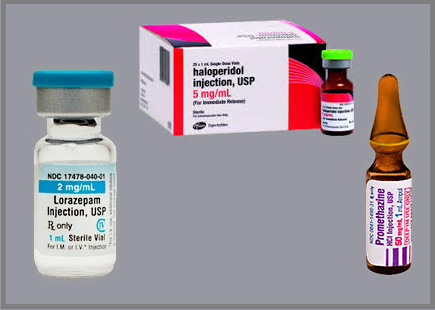Rapid Tranquillisation (RT) is defined on this website as
The use of medication to quickly reduce heightened emotional states such as agitation, aggression, violence or acute behavioural disturbance or the relief of distressing symptoms for the person.
http://www.RapidTranq.com/what-is-rapid-tranquillisation – Nov 2017
Other Definitions
Other definitions exist for RT the most current of which include
Use of medication by the parenteral route (usually intramuscular or, exceptionally, intravenous) if oral medication is not possible or appropriate and urgent sedation with medication is needed.
NICE 2015
The associated term ‘rapid tranquillisation’ refers to intramuscular injections and oral medication. Oral medication should always be considered first. Where rapid tranquillisation in the form of an intramuscular injection is required, the prescriber should indicate the preferred injection site having taken full account of the need to avoid face down restraint.
Worldwide most mental health providers, for example, seem to refer to these definitions and some Australian policy documents appear to quote the older 2005 NICE guidance (now replaced by the above 2015 NG10 NICE document.
Typical Routes of Administration
Depending upon your clinical setting the route of administration may include
- Oral
- Intravenous (IV)
- Intramuscular (IM)
- Insufflation
- General Anesthetic
- Nasally (e.g Midazolam)
- Inhalation (e.g. Loxapine)
Typical Medications Prescribed for RT

The main types of drugs prescribed for RT are antipsychotics such as
- Haloperidol
- Risperidone
- Olanzapine
- Loxapine
- Ziprasidone
- Aripiprazole
- Perphenazine
sometimes given with an antihistamine usually
- Promethazine
and also separately or in addition to benzodiazepines such as
- Lorazepam
- Midazolam
This wide-ranging combination of prescribing is seen internationally when reviewing literature, in the UK NICE guidance gives practitioners a more limited choice initially of Lorazepam, Haloperidol and Promethazine.
(Our free RT flowchart is based on this.)
Professional, Legal and Ethical Considerations of Rapid Tranquillisation
As the use of RT is frequently given coercively, then the practitioner must satisfy themselves that they have considered the legalities, professional guidance and ethics of its use. This is in addition to the normal requirements of staff administering any medication.
Post Administration
Following the administration of rapid tranquillisation professionals must continue to interact, observe and support the person and document and record the event with the person and plan future improvements/changes to their care and support. This process should include
- Documentation
- Medication, dose, route
- Reason for RT rather than another strategy
- Reason for not using preferred oral route (where applicable)
- Person’s views/account recorded
- Staff involved
- Outcome i.e. did it have the desired effect
- Suggested monitoring plan
- Debrief & support
- Longer-term plans / Future strategies (in partnership with the person)